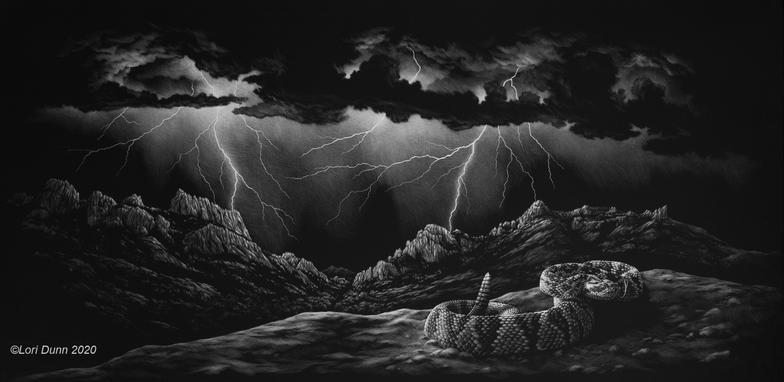LORI DUNN SCRATCHBOARD ART
promoting conservation through artistic efforts
Fully Charged
12 x 24
SOLD
*Gold Award and People's Choice award
Masters category International Society of
Scratchboard artists annual Exhibition 2023
In 2017 I had the opportunity to travel to the Cave Creek Canyon area of Arizona with some fellow naturalists in search of the local wildlife, specifically birds and herps. What made this trip more exciting than the other times I had visited Arizona was not only that we were going to be in one of the most biologically rich areas of the state, near the Chiricahua mountains, but also that we would be there during the monsoon season. Summer in Arizona consists of westerly winds and extreme dry heat that curb the activity of much of the wildlife. It is a time of dormancy, and of the ultimate in survival of species that would perish if not for the shelter-in-place tactics they adopt to conserve vital moisture. It is the absolute worst time to visit the area in search of reptiles which are in deep hiding. By late summer, however, this super heated air creates a low pressure system that brings a vital change to the region.
A monsoon is considered a seasonal shift in predominant wind direction, and this happens in Arizona between late July and September when this low pressure draws winds from the East and South, and with them, moisture from the Pacific and Gulf of Mexico. The result is a season of violent storms that lavish the area with swaths of rain, and what occurs next is nothing short of an explosion of life. As if by some magic, animals emerge from hiding to take advantage of the renewed environment. A multitude of lightning strikes produce valuable nitrogen for the soil and the vegetation springs forth new growth. Sulfur and microorganisms in the rain also benefit this growth. Insects follow in the millions, and the subsequent domino effect of the food chain with them. Frogs emerge from the dry mud to relish in vernal pools and ditches, calling and breeding in a frantic race against time. Small mammals take advantage of an abundance of prey. Birds thrive. Amidst all of this action, snakes also appear out of nowhere. This time, in Arizona, is a naturalist’s fantasy come true, and as an avid snake lover, I was elated to take advantage of it. A highlight for me was my first encounter with a black tailed rattlesnake (Crotalus molossus). This heavy bodied species with gorgeous pattern and jet black tail has a presence about it that I find unmatched among other rattlesnakes in the area.
It was not a surprise to learn that several Native American tribes associated snakes with this time of storms and fertility, simply by association to their sudden appearance. According to Laurence Klauber (from his 3 volume series on rattlesnakes), Native Americans held a mingled “fear and reverence” to these animals and associated them with upper (lightning, thunder, rain) and lower worlds. The book “Venomous Reptiles” by Sherman and Madge Minton, tell of more specific anecdotes; The Shawnee tribe heard thunder as the voice of a celestial rattlesnake; The Sioux saw lightning as a rattlesnake striking its prey; The Mojave tribe have a myth about a giant rattlesnake that brings rain and thunder; and one of the most elaborate tales is from the Micmac tribesman who “saw the black cloud of an approaching storm as 7 flying rattlesnakes coiled about one another crying in the thunder as they crashed across the sky and appearing in streaks of lightning as they dived towards earth”. Rattlesnakes, it seems are the perfect icons for violent storms, likely due to their perceived irascible nature, the sudden onset of noise from a rattle, or a forked streak of lightning appearing similar to the forked tongue of a snake.
It was from all of the aforementioned inspiration that this piece was created. The black tailed rattlesnake and the backdrop of the mountains of Cave Creek canyon were based on my own photos from the trip, and although I witnessed many storms there, the clouds and lightning in this artwork come from my imagination. I happened to start this project just as the Covid-19 outbreak was first occurring. Thankfully, it was never intended to be a warm and fuzzy artwork. It somehow seems fitting that it was created during an event fraught with chaos and uncertainty. There is a lot to look at, and I wanted the viewer to get a palpable sense of anticipation and adrenaline. I also intended for the snake to be reacting to the coming storm. It is alert, and in response to the vibration of the thunder, has its tail at the ready while testing the air with slow up and down flicks of its tongue – a behavior quite different from a snake which is seeking prey.
*Many thanks to friend, snake expert and bibliophile Grant Ankenman for looking up references in his vast library for me regarding Native Americans and rattlesnake lore, and to fellow artist Rod Rodman Leisure for providing a skilled pair of eyes while I was struggling with my imaginary sky.
Click on the magnifying glass to see some close ups of Fully Charged!
